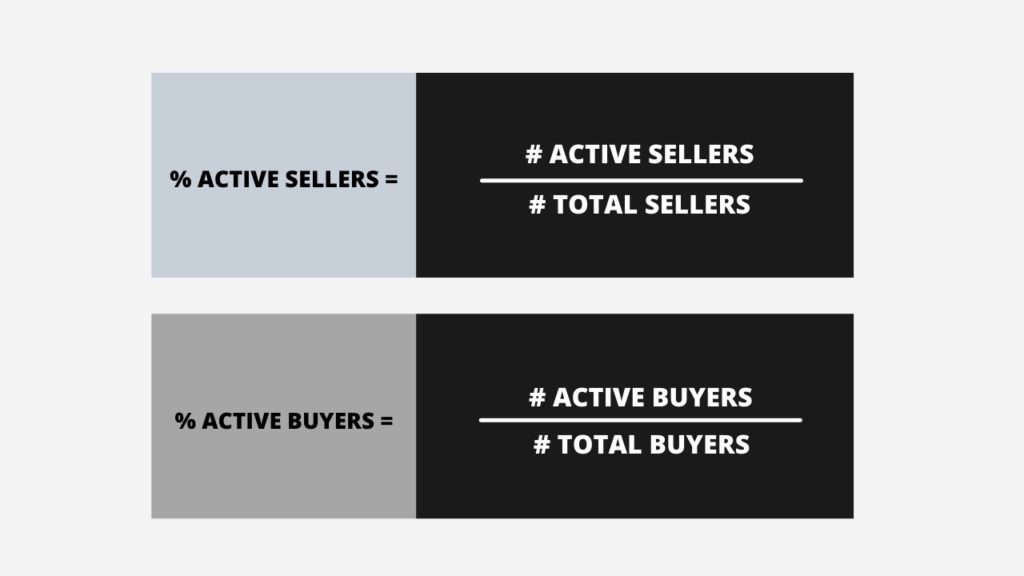What is a search to fill?
In busy marketplaces, the “search to fill” or “fill ratio” is a crucial metric that must be tracked and maintained. It is the proportion of searches that finally result in the sale of a product to the total number of searches. Let us understand how the concept of fill ratio works through the following illustrations:
- On Airbnb, OYO, or Trivago, the fill ratio is the number of search sessions that result in hotels or rented rooms bookings.
- On Amazon or Flipkart, it’s the percentage of searches that resulted in online purchases.
- On Care.com, Thumbtack, or Naukri.com, it’s the percentage of ride requests that resulted in the job placement of a candidate.
- On Ola or Uber, this is the percentage of searches that resulted in bookings and rides.
A higher fill ratio is directly proportional to the success of a marketplace. It also guides the service providers towards their lacking side. Thus, they can effectively analyze which side to focus more on for boosting their sales.
Type of Marketplace
The first and foremost step to strategize your next step is to identify the type of your marketplace. By doing so, you can make out the most of it. You can figure out how to leverage various dimensions to enhance your marketplace’s fill ratio.
According to the well-known economist and co-founder of Rev.com, Mr. Josh Breinlinger, marketplaces are of the following types:
- Double Commit Marketplaces
These markets facilitate direct interaction between the service providers and the customers. Here, the market act as an intermediate platform. Value or services are given and received by both ends.
Some examples of such marketplaces are Care.com, Upwork, Thumbtack, etc. In these types of job alerts platforms, the organizations invite candidates and candidates to apply for jobs. Thus, it enables its users to communicate either way.
- Buyer-Picks Marketplaces
In this category of marketplaces, buyers can choose between the available suppliers. Suppliers update the availability of products & the buyer chooses his supplier without any direct discussion.
For example, Airbnb, Trusted, YourMechanic, etc.
- Supplier-Picks Marketplaces
In this category of marketplaces, the buyer posts job vacancies. It enables the approved suppliers to see the available jobs. Finally, the supplier claims the given post.
For example, companies like Uber, Lyft, Doordash, Postmates, Pared are supplier-picks marketplaces.

How to measure the Search to Fill?
After going through the listed advantages, you might wonder how exactly to measure this magical fill score. To utilize the full potential of the fill ratio, keep a record of the fill scores of monthly, weekly, daily, and hourly sales.
Analyze the conditions when it reached its maximum and minimum values. It will help you to analyze your strengths and weaknesses. In this way, you’ll be able to work upon your shortcomings. If possible, try to track the number of unfilled searches overall by an hour of the day/ day of the week for the last four weeks.
Time to Fill
Its importance increases four folds in marketplaces where multi-tenancy is common.
In a supplier-picks marketplace, there is high competition on the supply side. Despite its high fungibility, its fill ratio isn’t practically 100%.
Suppose someone books a cab from Ola or Uber. Either the driver may be very far away from the customer his ratings may not be good. In such cases, the customer may change his mind and may opt for another service provider. These are the practical situations that bring down the fill ratio of supplier-picks marketplaces.
Pivoting on Geography
While the fill ratio is a crucial factor in determining the status of a company, it doesn’t suggest where exactly you are lacking. It may still be hard to figure out what operators need to tweak to enhance its fill ratio.
For example,
- Taking the geography and other such factors into consideration, Airbnb also tracks the location, number of rooms, amenities desired, etc.
- A pet agency may take the factors like age, the number of pets, possible ailments, and allergies into account to overall boost its fill ratio.
How to improve the fill ratio?
If you want to increase your fill ratio, the first thing you must do is analyze the current position and category of your marketplace. Identify your strengths and weaknesses. Compare your products and sales with the trend of current popular demands. For example, as a renting agency, you have lots of 1 bedroom accommodations, but the popularity of 2 BHK homes is rising. What will you do to tackle this risk situation?
Let’s have a look at the best options for you to upgrade your fill ratio:
- Inform the supply about the opportunity
It can prove to be a good idea to inform your supply about the requests on the demand that are going unmet. It would give a forward push to the sales and increase your search to fill ratio.
- Dynamic Pricing
Instead of keeping your charges fixed, you may vary them according to the demand and supply. The zones with higher demands are assumed to have higher multiples or surges too.
- Offering Alternatives
You may come across situations where you can’t fulfill the exact demand of the customer. At such places, you may recommend to them the alternatives related to their search. There are high chances that they may consider your recommendations. This strategy has worked well for marketplaces like OpenTable and Resy. However, the efficiency of this method may also vary according to the type of marketplace.
Conclusion
For homogenous supply marketplaces, as the depth of the market increases, the addition of the supply no longer affects the fill ratio. For example, it would make no difference if you have either 4 or 6 scooters to use in your vicinity. We can say that the user value remains unchanged.
On the other hand, for heterogeneous supply marketplaces, there is no peak threshold. The addition of the supplies would always add to the value. For example, at Airbnb, adding the newest platforms will always be convenient for the users to see and compare.

